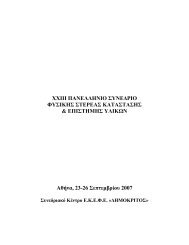Iron(III) Chemistry with Ferrocene-1,1-dicarboxylic Acid (fdcH2 ...
Iron(III) Chemistry with Ferrocene-1,1-dicarboxylic Acid (fdcH2 ...
Iron(III) Chemistry with Ferrocene-1,1-dicarboxylic Acid (fdcH2 ...
You also want an ePaper? Increase the reach of your titles
YUMPU automatically turns print PDFs into web optimized ePapers that Google loves.
Inorganic <strong>Chemistry</strong><br />
Figure 7.<br />
57 Fe M€ossbauer spectra in zero applied field for powder<br />
samples of 1 in the 4.2 250 K temperature range. The contribution of<br />
the ferrocene doublet is shown <strong>with</strong> the orange line.<br />
species is not sensitive to the relative orientation of the rings, in<br />
agreement <strong>with</strong> theoretical calculations. 25<br />
The rest of the spectrum consists of a relatively broad,<br />
asymmetric doublet <strong>with</strong> peaks at þ0.20 and þ0.65 mm s 1<br />
<strong>with</strong> an average isomer shift of ∼0.40 mm s 1 and average<br />
quadruple splitting of ∼0.45 mm s 1 . This part of the spectrum is<br />
expected to contain contributions from the seven FeO 6 sites and<br />
the [FeCl 4 ] and ferricenium moieties. However, no special<br />
features can be resolved that could lead to an unambiguous<br />
discrimination of the different Fe <strong>III</strong> species.<br />
The doublet attributed to the ferrocene site of fdc 2 accounts<br />
for only 22% of total iron at 250 K, which is significantly lower<br />
than the expected value of ∼36% for five fdc 2 ligands per<br />
molecule. This cannot be due to only three fdc 2 ligands per<br />
molecule (predicted 21% of total Fe) because this would be<br />
completely inconsistent <strong>with</strong> the other data. We instead believe<br />
that this is due to the various iron sites being characterized by<br />
ARTICLE<br />
different Debye Waller factors. Such effects have been seen, for<br />
example, in biferricenium complexes, where the ferrocene Debye<br />
Waller factor has been reported to be smaller than other Fe<br />
sites at higher temperatures. 26 In other words, the Debye Waller<br />
for the ferrocene groups in 1 is smaller and their contribution<br />
is thus underestimated in comparison <strong>with</strong> the other iron sites at<br />
elevated temperatures. Indeed, as the temperature decreases the<br />
contribution of the fdc 2 ferrocene doublet increases and below<br />
20 K accounts for ∼36% of total iron, the expected percentage<br />
for five fdc 2 per molecule. The quadruple splitting for the<br />
fdc 2 ferrocene doublet does not exhibit any temperature<br />
dependence, and the lines remain narrow. Therefore, the liquid<br />
helium spectra provide compelling evidence that 1 contains five<br />
ferrocene (fdc 2 ) and one ferricenium (fdc ) groups. 21<br />
Below 120 140 K, the rest of the spectrum exhibits a rather<br />
unexpected behavior. As the temperature decreases, the central<br />
doublet loses intensity, and this decrease is accompanied by the<br />
development of a magnetically split spectrum (sextet). It is<br />
important to emphasize this; the sextet gains intensity as the<br />
central doublet loses it, that is, the relative area ratio of the<br />
ferrocene doublet and the other features combined at liquid He<br />
temperatures remains that predicted by the crystal structure of 1.<br />
This thus excludes the possibility that the sextet is due to iron<br />
impurities, and that it could not be observed at higher temperatures<br />
because of broadening effects, or similar. The iron sites that<br />
contribute to the sextet are thus among the ferric sites of the Fe 7<br />
core and/or the ferricenium site. The [FeCl 4 ] anion is not<br />
expected to contribute to the sextet because of its minimal<br />
interactions <strong>with</strong> the cation, and it is thus unlikely that there<br />
are significant anion/cation exchange interactions; this was also<br />
inferred from the magnetic susceptibility measurements above.<br />
Because of fast spin relaxation, the [FeCl 4 ] anion in complex<br />
salts gives rise to a M€ossbauer singlet <strong>with</strong> δ ∼ 0.35 mm s 1 at<br />
liquid helium temperatures and above. 27 In the present case, the<br />
singlet from the [FeCl 4 ] anion accounts for only 7% of total<br />
iron and would be buried under the central doublet. As a<br />
consequence, we believe that the sextet arises from magnetic<br />
interactions <strong>with</strong>in the Fe 7 core, involving also the S = 1 / 2<br />
ferricenium group.<br />
The sextet is rather broad even at 4.2 K, and the resolution of<br />
the spectra does not allow us to identify the contribution of each<br />
ferric site. Each of the four types of Fe <strong>III</strong> sites is expected to be<br />
characterized by different hyperfine fields, and this, in combination<br />
<strong>with</strong> possible relaxation effects, would result in substantial<br />
line broadening. Rough simulations of the spectra were carried<br />
out to estimate the average hyperfine fields of the magnetic<br />
sextets. The temperature dependence of (i) the average hyperfine<br />
field of the magnetic sextet, and (ii) the percentage of<br />
magnetic sextet relative to the central doublet, are shown in<br />
Supporting Information, Figures S5 and S6, respectively.<br />
The average hyperfine field exhibits an apparent increase down<br />
to 20 K and then remains constant (Supporting Information,<br />
Figure S5). The gradual conversion of the central doublet to the<br />
magnetic sextet does not follow the behavior expected for typical<br />
slow relaxation as it is manifested in other polynuclear iron<br />
clusters. 29 Rather, the behavior of the spectra of 1 is reminiscent<br />
of systems <strong>with</strong> spin correlations, but the magnetic susceptibility<br />
measurements do not indicate long-range magnetic ordering.<br />
Interestingly, similar behavior was observed recently for a<br />
Dy <strong>III</strong> 3Fe <strong>III</strong> 7 cluster whose zero-field M€ossbauer spectra on powder<br />
samples below 15 K exhibit magnetic sextets <strong>with</strong> temperaturedependent<br />
hyperfine fields. 29 The behavior of the M€ossbauer<br />
5652 dx.doi.org/10.1021/ic200348s |Inorg. Chem. 2011, 50, 5646–5654
















